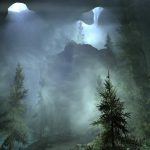“Skyrim’s” evergreen appeal
Bethesda Games Studio’s first-person, open world action role-playing game, “The Elder Scrolls V: Skyrim,” first released in November 2011 and has been one of the most popular, lauded and influential games in recent history. Originally made for the Xbox 360, Playstation 3 and Windows PC, the visually revamped “Special Edition” released on Playstation 4, Xbox One and PC last Friday.
And yet people haven’t stopped playing the original “Skyrim.” In fact, it’s still frequently brought up on Reddit’s popular gaming forum. So what exactly is it that makes Bethesda’s 2011 work so very enduring?
The answer has to be its world. If you’re not familiar, “Skyrim” is set in its namesake — the Imperial province of Skyrim which lies at the far northern edge of the continent of Tamriel. The land is split between icy mountains, vast tundra and forests full of man-eating bears — and inhabited by the Viking-inspired Nord race.
But there are plenty of games that draw inspiration from Norse mythology — and plenty of open-world ones at that. What sets “Skyrim” apart is its connected world. Players can walk from the arctic sea all the way up to the tallest mountain in the world and over all of the hills and valleys in between. “Dragon Age: Inquisition” (2014) and “The Witcher 3: Wild Hunt” (2015) — “Skyrim’s” more recent contemporaries — have awe-inspiring worlds, but break them up into different regions and zones. Every game wants to have that wind blasted, snowy mountain top — because that’s just cool — but it loses something if there are no transitions.
If Skyrim’s wildernesses bring breadth, its dungeons provide depth. Dungeons are everywhere in this game. From busy cities to ruins hidden away deep in the forest, players never know what they’ll find when stepping through an (admittedly long) loading screen to enter a dungeon. At times they will see the bronzed, steampunk dwarven ruins that open up into underground caverns where mushrooms glow dimly with bioluminescence. Certain caverns play host to dramas told either by journals left by the long-dead or by fortune-seekers who yet live. Others still are oil-lit Nordic tombs where the long-buried draugr roam the halls. Players often head through these ruins to find themselves high above their entrances, looking over the forests and rivers below.
And the soundtrack ties all of this real estate together. Jeremy Soule’s ambient score captures the feeling of existing in the boreal forests, warm taverns and wind-swept mountaintops. Like most games, specific songs are mapped to begin playing when the player enters a certain area. However, outside of the city-specific themes, “Skyrim” has a more natural audio mix. Ambient melodies and full songs weave in and out as players cross hill and vale, enter combat and discover new lands.
“Skyrim” possesses a rather simple, workman- like combat and physics system. However, the varied locations and dungeons bring out its best. It can’t not be fun to fight on a fallen tree spanning over a river-carved ravine. The skill system — which ranges from sword fighting and archery to potion brewing and illusory magic — adds further incentive to explore. In contrast with other games where players gain experience by defeating enemies and completing quests, “Skyrim’s” skills level up individually based on usage. When players sneak up to enemies often, they will level up their stealth skill. If they cast spells to heal themselves, players will level up their restoration skill and so on. Higher levels unlock additional perks such as silent spell-casting and the ability to zoom in with bows.
The world, when combined with all of these gameplay elements, creates a unique explorative adventure. When all of these systems come together to form a single experience, it’s not hard to see where “Skyrim’s” longevity comes from.






